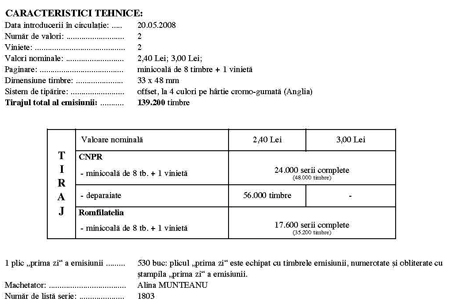 One hundred years ago, in the presence of King Carol I, King Ferdinand, and Princess Maria, the National Natural History Museum would officially open its doors in a new “Highway” building. One hundred years ago, in the presence of King Carol I, King Ferdinand, and Princess Maria, the National Natural History Museum would officially open its doors in a new “Highway” building.
One hundred years ago, in the presence of King Carol I, King Ferdinand, and Princess Maria, the National Natural History Museum would officially open its doors in a new “Highway” building. One hundred years ago, in the presence of King Carol I, King Ferdinand, and Princess Maria, the National Natural History Museum would officially open its doors in a new “Highway” building.
To celebrate the event, Romfilatelia introduces into circulation the postage stamps issue Centenary of the “GRIGORE ANTIPA” National Natural History Museum.
The history of the museum goes further back in time, in 1834, when the ruller Alexandru Ghica endorsed the setup decree of the National Museum Bucharest. The first collection´s curator was Carol Wallenstein de Vella (an Austrian of Croatian origin) in 1837. Then followed the tutor Carlo Ferrerati (Italian) in 1860, and in 1867, Prof. Gregoriu Stefanescu was elected museum director.
In 1893, Grigore Antipa was appointed director of State Zoological Collections. One year later, these collections are moved to new headquarters, in a building on Polona Street.
The construction of the new headquarters in Victoriei Square begun in 1904 and the building was finalized and inaugurated within four years and it was designated as the Museum of Zoology. With the inauguration of the museum, the first zoo-geographical dioramas in the world were revealed (Tundra, Prairie, African Savannah, and Sahara) and due to their high quality served as a model for many museums in the country and outside its borders.
6 years after this event, in 1914, occasioned by the inauguration of 11 new presentation halls, King Carol I grants a new name to the institution, namely the National Natural History Museum.
In 1933, as a recognition of Grigore Antipa´s merits, King Carol II names the museum after the famous scholar biologist, evolutionist, ichthyologist, ecologist, oceanologist, museum´s custodian and economist.
The “Antipa” Museum, one of the richest in the world, hosts more than two million exponates. Most of these are to be found in the 39 halls of the museum. The exponates cover various domains such as: zoology, mineralogy, anthropology, paleontology, compared anatomy, ethnography.
During the years, the museum enriched with scientifical collections among other, including items that are unique in the world. Of extreme importance are the creature group collections out of which we hereby include The “Aristide Caragea” Butterfly Collection, counting more than 120,000 items, The “Bielz” Mollusc Collection, with more than 90,000 items, The “Petre Banarascu” Fish Collection, with more than 5,000 items, The Collection of Sea Invertebrata “Mihai Bacescu”, with more than 11,400 items, The Collection of Mammals from around the world and the local Romanian fauna counting more than 8,000 items, and the Collection of Birds from local fauna and abroad with more than 9,000 exponates. At the same time, the museum enriches with every single year passing by with all sorts of materials that are either donations or brought about by the work conducted by the museum researchers or by means of internal or external expeditions performed by specialists.
We hereby wish to express our gratitude to the management team of the “Grigore Antipa” National Natural History Museum in Bucharest for all their help and assistance granted for the release of this philatelic issue.
Issue date: 2008-05-20
















